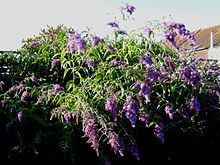Cultivar 'Dartmoor' | Origin Dartmoor, UK | |
 | ||
Similar Buddleja davidii 'Harlequin', Buddleja davidii 'African Q, Buddleja davidii 'White Bo, Buddleja davidii 'Markeep, Buddleja davidii 'Pink Spr | ||
Buddleja davidii 'Dartmoor' is arguably the most unusual davidii cultivar ever raised. Reputedly cloned from a plant found growing in a small ravine on Dartmoor near Yelverton by a retired American gardener by the name of Hayles, the shrub was introduced to commerce in 1973 and accorded the RHS Award of Garden Merit (record 678) in 1993 (reaffirmed 2010). [1]
Contents
Description
'Dartmoor' is instantly recognizable by its unique magenta inflorescences comprising compound, branched panicles, 20–30 cm long, instead of the typical single, terminal spike. The shrub can grow up to 5 m in height, the green foliage unremarkable and all but identical to the type. The weight of the large inflorescences causes the ends of the branches to droop, bestowing a distinctive, arching structure.
Cultivation
'Dartmoor' is now very common in cultivation on both sides of the Atlantic, and is hardy to - 15° C. Like most other davidii cultivars, it responds well to heavy pruning in spring. Hardiness: RHS H5, USDA zones 5–9.
